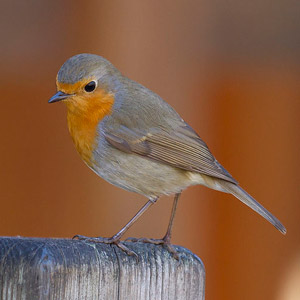Pratique | Débuter
Le rôle du géomagnétisme dans l’orientation des oiseaux

Des Rougegorges familiers (Erithacus rubecula) soumis à un champ magnétique artificiel orienté différement de celui de la Terre ont été perturbés dans leur migration.Photographie : Pierre Selim / Wikipedia
Introduction
Les oiseaux utilisent des sources multiples d’informations pour s’orienter, comme le soleil pour les migrateurs diurnes, ou les étoiles pour ceux qui voyagent de nuit.
Mais il faut qu’au moins une partie du ciel soit visible. Or beaucoup d’oiseaux sont aussi capables de s’orienter quand le ciel est caché par des nuages, ou par temps de brouillard: ceci suppose l’utilisation d’autres outils.
Plusieurs études ont établi que certaines espèces étaient sensibles au champ magnétique terrestre. Dans cet article, nous vous présentons les hypothèses actuelles concernant le rôle du champ magnétique terrestre dans l’orientation des migrateurs.
Une étude publiée le 29 octobre 2009 dans la revue Nature démontrerait que la détection du champ magnétique se ferait au niveau de l’œil.
Abstract
Birds use multiple sources of directional information for navigation, e.g. the sune for diurnally-migrating songbirds. Nocturnally-migrating birds cannot use the sun, but use the stars for orientation. However, use of the sun or stars requires that at least part of the sky is visible to the birds. Many birds are also able to accurately orient when the sky is not visible: this requires non-visual sources of information. Many studies have established that birds are sensitive to the Earth’s magnetic field. Some birds use the geomagnetic field as a compass, and are also sensitive to slight temporal and spatial variation in the magnetic field that are potentially useful for determining location.
In a recent study appearing October 29, 2008 in Nature, a visual center in the brain and light-sensing cells in the eye and not magnetic sensing cells in the beak of European Robins would allow songbirds to sense which direction is north and migrate correctly.
Poursuivez la lecture de cet article, en vous abonnant dès maintenant !
Découvrez les Archives d’Ornithomedia.com
Pour seulement 10,00 €TTC/an (ou 6,00 € les 6 mois)
Profitez de plusieurs centaines d’articles en accès illimité et sans aucun engagement.
Compléments
Auteur
Ornithomedia.com
À lire aussi sur Ornithomedia.com
- L’orientation chez les oiseaux
- L’ouïe : nouvelle théorie pour expliquer l’orientation des pigeons migrateurs ?
- La cohérence quantique serait impliquée dans l’orientation magnétique des oiseaux
Ouvrages recommandés
- Orientation in Birds de P. Berthold
- Migrations d’oiseaux de R Naranjo
- Le grand envol de Guilhem Lesaffre
Sources
- Beason, R. C. (2005). Mechanisms of magnetic orientation in birds. Integrative and Comparative Biology 45. Pages 565–573
- Heyers D, Manns M, Luksch H, Gu¨ ntu¨ rku¨n O, Mouritsen H (2007). A Visual Pathway Links Brain Structures Active during Magnetic Compass Orientation in Migratory Birds. PLoS One 2(9)
- Iannis Kominis, Quantum Zeno Effect Underpinning the Radical-Ion-Pair Mechanism of Avian Magnetoreception, Nature
Maeda, K., K. B. Henbest, F. Cintolesi, I. Kuprov, C. T. Rodgers, P. A. Liddell, D. Gust, C. R. - Timmel, and P. J. Hore (2008). Chemical compass model of avian magnetoreception. Nature.
- Thorup, Kasper, Bisson, Isabelle-A., Bowlin, Melissa S., Holland, Richard A., Wingfield, John C.,
- Ramenofsky, Marilyn, et Wikelski, Martin (2007). Evidence for a navigational map stretching across the continental U.S. in a migratory songbird
- http://people.eku.edu/ritchisong/birdbrain2.html
- Laura Sanders (2009). Birds’ eyes, not beaks, sense magnetic fields. Sciencenews. Date de mise à jour: 28 octobre. www.sciencenews.org




Aucun commentaire sur ce sujet
Participer à la discussion !